
Last weekend I attended the Sikh Lens Sikh Art and Film Festival in Hollywood. I have attended film festivals all over North America and strongly believe in their need and presence in our community. Many times, however, the events get overshadowed by the glitz and glamour – the red carpet, the photographers, the eccentric outfits… I was therefore grateful that my experience at the Sikh Arts and Film Festival was a fulfilling one – I left knowing that Sikh Arts and Films bring value to our community and need to be supported. In addition, I felt the organizers made a special effort to keep the event focused on the directors, artists, musicians, actors, authors and organizations who were present. They recognized the fact that we are all in this together. Sikh Arts and Films are only beginning to be acknowledged, there is so much potential and growth that will still occur. However, this isn’t going to magically happen overnight, and it most definitely won’t happen without the community’s support.
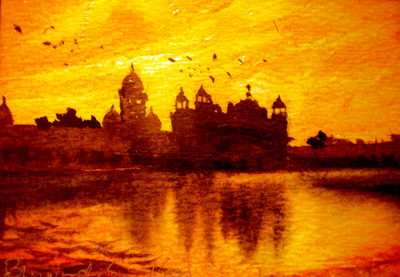 I was recently told that Sikhs in the UK spend 7 times more on license plates than they do on books (yes, 7 times!). While I’m not sure of the statistic in the US, the point is clear – perhaps we’re not investing in the right places? I think as a community we have begun to establish the need to support non-profit organizations that are working to address human rights, legal, education and activism issues (although we still have a long way to go to enhance our support). However, what goes hand in hand with this is the support and advancement of Sikh Art and Media. Without a doubt, events such as Sikh Lens are helping to pave the path – however, we as a community need to ask ourselves why we are so hesitant to spend money on independent films, children’s books, on historical references and on paintings. When I think about other immigrant communities, I notice that their advancement as a community comes from their support of one another. Whether we like to admit it or not, our community is extremely frugal and competitive with each other, and unless we start to move away from those stereotypes – we will not be creating a better world for our children.
I was recently told that Sikhs in the UK spend 7 times more on license plates than they do on books (yes, 7 times!). While I’m not sure of the statistic in the US, the point is clear – perhaps we’re not investing in the right places? I think as a community we have begun to establish the need to support non-profit organizations that are working to address human rights, legal, education and activism issues (although we still have a long way to go to enhance our support). However, what goes hand in hand with this is the support and advancement of Sikh Art and Media. Without a doubt, events such as Sikh Lens are helping to pave the path – however, we as a community need to ask ourselves why we are so hesitant to spend money on independent films, children’s books, on historical references and on paintings. When I think about other immigrant communities, I notice that their advancement as a community comes from their support of one another. Whether we like to admit it or not, our community is extremely frugal and competitive with each other, and unless we start to move away from those stereotypes – we will not be creating a better world for our children.
 I was really moved by this audio essay from Cecilia Muñoz titled “A Little Outrage Can Take You a Long Way” on NPR’s This I Believe segment.
I was really moved by this audio essay from Cecilia Muñoz titled “A Little Outrage Can Take You a Long Way” on NPR’s This I Believe segment.
In her reflection on activism, I connected with the statement about defeats outweighing victories, and how it motivates her to continue her work. Like many of the TLH readers, I too take time out my schedule for service activities. And after serving 100 or so meals at a homeless shelter, I go home feeling good about myself and the good deed I had done. Unlike Muñoz, I don’t stay awake thinking of the 100 or so people who were turned away that day at the shelter, or those who wouldn’t have a place to sleep that night. Maybe this is what separates me from real activists. To me, service has become an event or an activity – for an activist, service is a part of their life…part of who they are. They are constantly looking for ways to serve.
And I agree with Muñoz, “a little outrage can take you a long way.”
Although I don’t believe Guru Nanak was motivated by anger, I do believe he was outraged. Outraged by a society complacent with the rigid caste hierarchy, outraged at the imbalance of justice, and outraged by the barbaric methods of the State to suppress a minority. You can almost hear the outrage, when Guru Sahib describes the horrific events of Babar’s invasion:
Two great events are happening this Saturday: in San Francisco- “Women in 1984”; in New York- Lahir.
If you’re anywhere near either of these 2 cities, you better be there, or you’ll regret missing out!
Women in 1984
Dr. Cynthia Mahmood’s work deals directly with the issue of militancy and she will discuss the violence in Punjab from the macro lens of India as a democracy.Navkiran Kaur Khalra will speak of her own experiences as the daughter of S. Jaswant Singh Khalra and the heritage of his vision. The Khalra family’s narratives is inherently linked to the states backlash against movements desiring human rights and autonomy.Jasmine Kaur Marwaha, human rights lawyer for Ensaaf, will be discussing the the right to reparations for victims of the November 1984 pogroms, as well as victims of the Punjab counterinsurgency, from a gendered perspective.
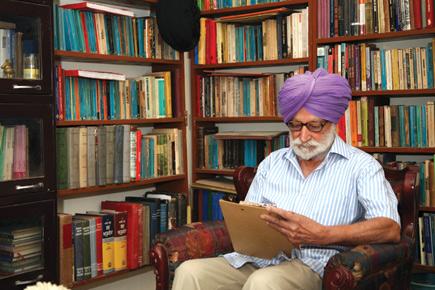 To be or not to be? Well, apparently for Surjit Singh Hans – it is to be. Hans, an academia based in Mohali, is undergoing the feat of translating Shakespeare’s work into Punjabi. Hans retired from Guru Nanak Dev University in Amritsar, where he had once been head of the department of history having done extensive work on Sikh literary sources and in particular the Janamsakhis. He has been working on this task for the past sixteen years.
To be or not to be? Well, apparently for Surjit Singh Hans – it is to be. Hans, an academia based in Mohali, is undergoing the feat of translating Shakespeare’s work into Punjabi. Hans retired from Guru Nanak Dev University in Amritsar, where he had once been head of the department of history having done extensive work on Sikh literary sources and in particular the Janamsakhis. He has been working on this task for the past sixteen years.
The translation follows the original line by line—you want to locate line 20, Act II, scene (i), in the Arden edition of Hamlet, all you have to do is look at the corresponding line in the translation. The iambic pentameter of Shakespeare has given way to the chaupai in Punjabi, but what matters is that these lines are almost as resonant in Punjabi as they are in the original English. They work well when read aloud, as Shakespeare is meant to be, and there is little here that a Punjabi can’t take to heart. Indeed, the heavy-headed revelry ‘takes from our achievements, though performed at height’. [link]
As for how well Shakespeare’s work translates into Punjabi, Hans suggests that King John could parallel the story of Aurangzeb and Two Noble Kinsmen could be a scene out of a Punjabi village (two men, one girl – hardly promising).
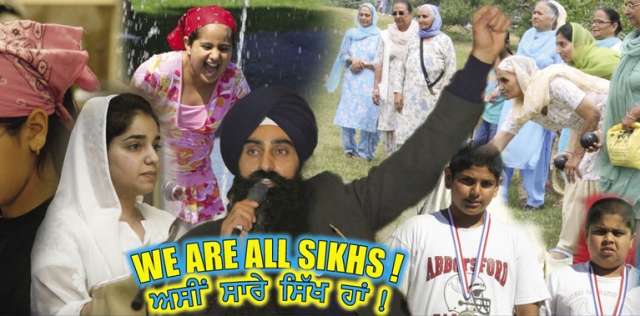 Although Gurdwara elections are usually not celebratory topics, the news surrounding the Guru Nanak Sikh Gurdwara in Surrey is especially noteworthy. We have covered the topic in the past a few times and the results seem to be in (again). The Youth Slate wins (again).
Although Gurdwara elections are usually not celebratory topics, the news surrounding the Guru Nanak Sikh Gurdwara in Surrey is especially noteworthy. We have covered the topic in the past a few times and the results seem to be in (again). The Youth Slate wins (again).
An overwhelming reason the story is worthy of discussion is due to the Canadian national media own interference and frequently call for Sikhs to vote against the “fundamentalist”/”conservative” slate. Statements such as these were far too common:
If elected, a slate of Sikh youth fundamentalist candidates could overturn a long moderate tradition of using tables and chairs for temple mealtimes.[link]
Well the community decided again and returned the “fundamentalist” candidates. I wonder if the Canadian media has ever delved and chose sides and support in church elections in the past? For some reason, I have a feeling this is rather a unique scenario. Although the media may not like the results the community speaks for itself.
The new committee under Bikramjit Singh will have a lot of work to do. They hardly built confidence after the last election, when it was discovered there were irregularities in their nomination processes. Still their agenda is broad and may have long-term ramifications in Surrey.
Regardless a victory of the community over the Canadian media’s portrayals and desire for specific results. Now we wait and see. The real work is about to begin.
Flu season along with H1N1 are in full swing right now. We worry about catching it at schools, in airports, and work. Often we hear of recommendations for people to stay home if they are sick so they don’t infect their co-workers and give themselves time to get well. However, for some staying home when you are sick comes at a large cost-a day(s) worth of wages. According to the Union Voice, “Thirty-nine percent of us have a difficult choice to make when we’re sick: go to work and risk infecting our co-workers (and risk making our illness worse), or stay home and put our finances and our jobs in jeopardy”. (hat tip: Sonny)
Thus, Senator Chris Dodd and Rep. Rosa DeLauro are pressing forward the passage of the Healthy Families Act, which was first introducted by Senator Edward Kennedy.
The Healthy Families Act would provide 7 paid sick days to all workers at companies with at least 15 employees, and would prevent employers from retaliating against workers who get sick. The bill has 113 sponsors in the House and 21 sponsors in the Senate, and has been endorsed by the Obama administration.
This bill would ensure that 3/4 of workers in the food and service industry who do not get paid sick days will be able to stay home rather than come into contact with their co-workers and the public. Taking action to pass this bill will be a positive step forward in fighting the spread of H1N1.
TAKE ACTION NOW by clicking here and sending your congressional representative an e-mail asking him/her to support this bill.
By neglecting art, we’ve been neglecting our spirituality. And perhaps vice versa. Perhaps we could practice receiving a little more, instead of doing, as we normally do.
Most of us, especially in Asian communities that so highly value scientific endeavor, and want the next generation to all be doctors, grossly undervalue art. Sadly, this might be stunting our spirituality.
How often have your teachers, parents, and other adults in your life impressed upon you the importance of active effort, purposeful thought, and discipline? The scientific methods we rely upon to explain our environments and the universe all rely on these traits and oh-so-important- rationality. Through decades of education, we’re pounded into submission, learning to accept that rationality is good, and irrationality, bad.
But that’s not entirely true. And in the last week, I noticed that both Japji Sahib and a popular American site (especially amongst techies) bypassed rationality to focus on the importance of a different kind of knowledge – intuition. And it rang true. Intuitively. Irrationally.
From the 13th Pauri of Japji Sahib:
Kash Gill, who grew up as a farm worker, will be sworn in today as Yuba City’s first Punjabi-American mayor. As many of you know, Yuba City (often referred to as the pindh of California), has a large Punjabi Sikh population. Just last weekend, 75,000 people gathered in Yuba City for the annual Nagar Kirtan. It is perhaps not surprising, therefore, that finally a Punjabi-American will be taking the seat of mayor. The event does, however, signify a signficiant step for a community that makes up about 12 percent of the population in Yuba City. The story also embodies the dream, which many immigrant communities carry with them – that by working hard and perservering, anything is possible.
“You’d never think you’d be picking peaches one day and the next day you’re the mayor of Yuba City,” he said. “That’s why we call it the land of opportunity.” After moving to the United States when he was 3 years old, Gill’s parents stressed that education was the path to leaving the life of farm laboring. [link]
Gill said his priority will be to improve flood protection for the community, reduce gang activity and offer opportunities for young residents. It should be added, that in Yuba City the mayor is chosen on a rotation system and while many of the comments (in the linked article) do discuss his Punjabi-American background, many more are focused on discussing his priorities and how they will benefit the people of Yuba City – as they should be.
Note: The Appeal-Democrat is hosting a live streaming video tonight of City Councilman Kash Gill being sworn in as mayor of Yuba City at www.appealdemocrat.com.
 This weekend Sikhlens will be presenting its annual Sikh Art and Film Festival 2009. The film festival showcases the best in Sikh movie-making talents from around the globe. It also presents a forum for aspiring Sikh artists to also come and display their burgeoning talents. A few book launches are planned with a particular emphasis on children’s books. Authors of A Lion’s Mane and The Royal Falcon are planned to be in attendance to do a live reading.
This weekend Sikhlens will be presenting its annual Sikh Art and Film Festival 2009. The film festival showcases the best in Sikh movie-making talents from around the globe. It also presents a forum for aspiring Sikh artists to also come and display their burgeoning talents. A few book launches are planned with a particular emphasis on children’s books. Authors of A Lion’s Mane and The Royal Falcon are planned to be in attendance to do a live reading.
The inaugural Sikh Art and Film Festival will be held at the historic Egyptian Theatre in Hollywood, CA on November 13-15th.
In previous articles on The Langar Hall, I have written about how certain Sikh-film haters groan in jealousy and spew hatred, about the Sikhs’ taking advantage of new forms of media. Such efforts in the community should be encouraged and more platforms created.
The weekend features a number of different clusters, highlighting issues on the youth, creative Sikhs, short films, feature films, and even Remembering 1984. The Remembering 1984 cluster on Sunday afternoon will be co-hosted with the Jakara Movement in conjunction with it’s Visions of Truth film series.
So whether you come for the entire weekend, make it out to just one cluster (at $15 pre-sale, you won’t find a better price), or at least to Sunday’s mela, check the schedule, check out the films, and make sure you come out and support Sikh arts! We’ll be in attendance and will post on our experience after the event.
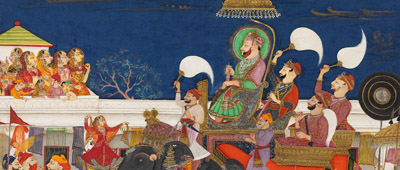 Guest Blogged by: Harinder Singh
Guest Blogged by: Harinder Singh
Last week I walked into the first exhibition to “comprehensively” explore the extraordinarily rich culture of the maharajas. “Maharaja – the splendor of India’s Royal Courts” is the feature exhibit at the Victoria & Alberta Museum in London and will be available through mid-January 2010. It was Susan Stronge, senior curator at V&A and friend of the Sikhs, who literally showed me the way to the V&A after a candid conversation over cafe latte about Sikhs, art, Orientalism, Barak Hussein Obama and Patwant Singh (late transnational Sikh ambassador). Her interest in my take on the Indian Maharaja’s depiction became the unusual catalyst to see the exhibition through two lenses: that of a Sikh and a South Asian.
Given that the number five in the Hindu numerology spans around business, marriage and romance, the five zones of exhibitions made sense. How the British have harbored such romantic notions of arbitrary boundaries of marriage and power in what it termed India! My journey through the exhibition started with the “Royal Spectacle” followed by the “Kingship in India.” It solidified with the “Shifting Power” that legitimized “The Raj’ which divided its subjects into “Princely India.” The only thing missing were the people, today’s South Asians.
The role of Sikh women often remembered in 1984 is that of victim. Yes women were raped, killed, and left to care for their families when their male relatives were kidnapped and killed. However, the strength and perseverance to move forward without justice is often glossed over. I find it powerful to hear Sikh women’s stories of “moving on” while continuing to speak out against the horrific injustices of 1984. Often there is talk about how Sikhs have been in a state of “victimhood” for the past 25 years. I believe the stories of the women below show how some Sikhs have empowered themselves to move forward with their daily lives in the past 25 years while living with the pain and not giving up on the demand for justice. This is agency and not victimhood.
Yes institutions, memorials, and marches show how Sikhs are attempting to move forward as a community; however, these women have done something that is far more difficult-picking up the pieces of their lives in the midst of devastation and mending them together as best as they could for themselves, their families, and their community. These women are inspirational and their lives for the past 25 years show why.
Watch the videos below in Hindi to hear their stories (hat tip: Mallika). One of the most powerful reflections of 1984 I have seen.
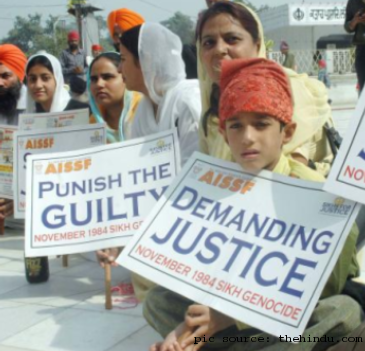 On Tuesday (November 3rd, 2009), various Panthic groups (‘radical’ Sikh organizations, if you follow Indian newspapers) called for a peaceful shutdown of stores, businesses, and state services to protest the continued impunity in which the perpetrators of the Indian Government-orchestrated pogroms in 1984 still roam free today.
On Tuesday (November 3rd, 2009), various Panthic groups (‘radical’ Sikh organizations, if you follow Indian newspapers) called for a peaceful shutdown of stores, businesses, and state services to protest the continued impunity in which the perpetrators of the Indian Government-orchestrated pogroms in 1984 still roam free today.
The ‘bandh’ was an overwhelming success in terms of its immediate call to action, although the larger purpose of its calling will probably continue to yield little results.
The strike call was given by the Dal Khalsa and was supported by the Khalsa Action Committee (KAC), Damdami Taksal, Delhi Sikh Gurdwara Prabandhak Committee (DSGPC), All India Sikh Students Federation (AISSF) and Shiromani Panthic Council.
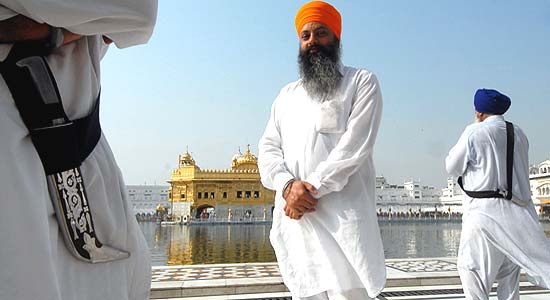 History often remembers transformative figures through the public images they become. Glimpses and insights into their private lives are rare. So an interview with Sant Jarnail Singh Bhindranwale’s son is a rare treat.
History often remembers transformative figures through the public images they become. Glimpses and insights into their private lives are rare. So an interview with Sant Jarnail Singh Bhindranwale’s son is a rare treat.
Ishar was just five years old when Jarnail Singh Brar was anointed the 12th jathedar of the Damdami Taksal. He left home and adopted the “Bhindranwale” after the village of Bhindran Kalan where the sect was originally located. “After that we only saw our father at his satsangs,” Ishar said. “But we were well looked after.” Did he miss his father? “From the family point of view I was sad, but from a Sikh point of view I was very happy.” The Jalandhar editor waved a laminated family photograph at me—a very young Ishar Singh with his eyes shut, an oddly self-conscious Sant Bhindranwale, his younger son Inderjit, his wife Pritam Kaur. [Outook India]
Ishar is the oldest of Bhindranwale’s two sons, and now a land realtor near Amritsar. He was 12 yrs. old during Operation Bluestar, studying Gurbani under Mahant Jagir Singh at Akhara village near Jagraon. [OI]
25 years ago history was made for several different reasons. Today, as we reflect on the invasion, on the assassination, and on the massacres, we come across multiple news articles which provide information and commentary on the events of that year. I wanted to take the time to document and highlight these articles as they’re worthy reads in providing information to readers around the world. I encourage you to read these pieces – they are vital to our understanding and they will inform Sikhs and non-Sikhs alike about events in our history.
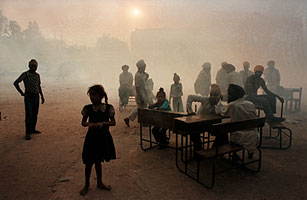 1. TIME magazine featured an article titled, “India’s 1984 Anti-Sikh Riots: Waiting for Justice.” Our readers have previously argued against the use of the word “riot” and suggested that “genocide” is the more fitting description of what happened. Regardless, this is an important article which discusses the often silent victims of 1984 – the widows and their children and the impact the events (and lack of justice) has had on their future.
1. TIME magazine featured an article titled, “India’s 1984 Anti-Sikh Riots: Waiting for Justice.” Our readers have previously argued against the use of the word “riot” and suggested that “genocide” is the more fitting description of what happened. Regardless, this is an important article which discusses the often silent victims of 1984 – the widows and their children and the impact the events (and lack of justice) has had on their future.
The widows’ colony in Tilak Vihar is a cheaply built and neglected cluster of homes, which were given by the government to hundreds of women and their children who survived what have become known as the anti-Sikh riots of 1984. But as the grim event’s 25th anniversary nears at the end of this month, crime, addiction and prostitution have taken root in what was supposed to be a survivors’ safe haven. Residents say this is because of the damage to the mental health of children who were witness to their parents’ and siblings’ murders and who grew up in impoverished homes and weren’t given any medical help — physical or mental — for their problems. [link]
Of note: for the 25th anniversary of the event, advertisements by Ensaaf — showing an old woman wiping away her tears, with the words, “25 years ago, our loved ones were burned alive in front of our eyes,” and in the next line, “Why has India, the world’s largest democracy, denied us justice?” — are scheduled for the month of November in the San Francisco Bay Area’s transit system!
 Through Sukhmani Sahibs, conferences, scholarships, film festivals, floats, and even ongoing camps, the Jakara Movement adds the next event to its on-going “Remember 1984″ campaign.
Through Sukhmani Sahibs, conferences, scholarships, film festivals, floats, and even ongoing camps, the Jakara Movement adds the next event to its on-going “Remember 1984″ campaign.
This November they begin their Remembrance Marches.
25 years ago there was a government-sponsored pogrom in Delhi and throughout many parts of India that left tens of thousands dead. Orchestrated by the Indian Government, the perpetrators of these pogroms roam free today. Join us and connect in solemn remembrance with Sikhs and non-Sikhs alike as we commemorate the events of 1984 and call for justice and bear witness to the genocide. We will not be silenced.[link]
The Event will consist of a series of silent marches in the various regions, followed by video screenings, speeches, and a candlelight vigil.
Attend one at a city near you:
- BAKERSFIELD – Silver Creek Park – Saturday, November 7th, 2009, 5-7pm
- BAY AREA – TBA
- FRESNO – Woodward Park – Monday, November 16th, 2009, 6-8pm
- RIVERSIDE – Glen Avon Heritage Park – Wednesday, November 18th, 2009, 6:30-8:30pm
For those in Bakersfield, this week (date to be updated) watch ABC affiliate KERO, Channel 23, to see members of the Jakara Movement talk about this weekend’s Remembrance March in Bakersfield.
For more information on the march visit the Jakara Movement blog, website, or Facebook page. See you there!
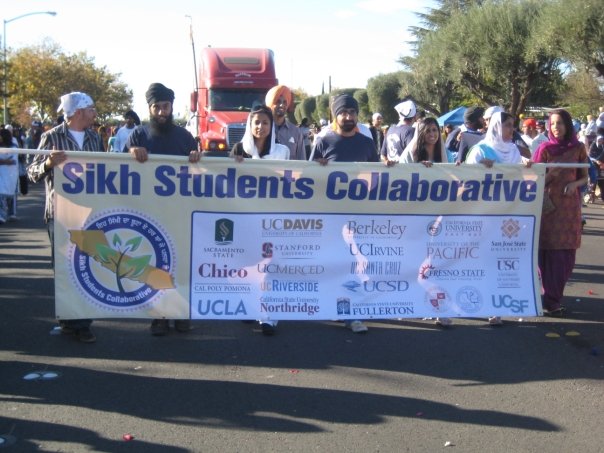 This past weekend was the 30th Annual Yuba City Nagar Kirtan (sometimes called the Sikh Parade). Thousands from all over California and beyond gathered for the weekend, doubling the population of sleepy Yuba City.
This past weekend was the 30th Annual Yuba City Nagar Kirtan (sometimes called the Sikh Parade). Thousands from all over California and beyond gathered for the weekend, doubling the population of sleepy Yuba City.
An estimated 75,000 people filled Tierra Buena and Butte House roads before the beginning of the parade, one of the largest annual gatherings of Sikhs anywhere outside Asia.[link]
We had mentioned before the float built by the Sikh Students Collaborative. The Appeal Democrat, Yuba City’s own newspaper, made special note of the float that seemed to have attracted plenty of conversation and provided fruits for conversation:
More floats followed, from businesses, school ethnic clubs and charities such as the American Red Cross’ local chapter. Some floats had a political message, such as one from a group of Sikh college students that warned of oppression against Sikhs in their native India.
Two men stood on the float with their heads positioned inside nooses, while words read, “A community will never forget.”[link]
Along with the float, the first annual Yuba City Youth Lecture and Discussion was conducted. Overall the weekend was a great success and too many of us are still exhausted. Special thanks to ALL those SSAs that lent their support and especially ALL OF THE VOLUNTEERS that were out until 2am working on the float. Leave your comments or thoughts. Below the link, see some pictures from the float.
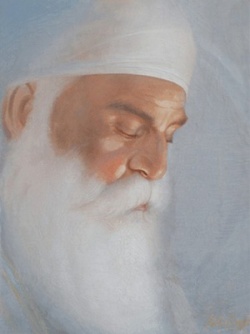 Gurpurab Greetings! As many of you know, today is Guru Nanak Dev Ji’s gurpurab. Guru Nanak Dev Ji bestowed much upon us, including the concepts of Naam Japna, Kirat Karni, and Vand Chakna.
Gurpurab Greetings! As many of you know, today is Guru Nanak Dev Ji’s gurpurab. Guru Nanak Dev Ji bestowed much upon us, including the concepts of Naam Japna, Kirat Karni, and Vand Chakna.
Naam Japna: Guru Ji taught us to directly practice Simran and Naam Japna – meditation on the word of the Guru and thus remembering God at all times.
Kirat Karni: Guru Ji taught us to live honorable lives and to earn honestly by our own physical and mental effort while accepting both pains and pleasures as the Guru’s gifts and blessings. Within this, is a reminder to stay truthful at all times.
Vand Chakna: We are taught to share our wealth within the community – especially with those who are most in need. The community or Sadh Sangat is an important part of Sikhi and this spirit of Sharing and Giving is an important message from Guru Nanak.
While today is a day of celebration, it is also a reminder to each of us to consider how we choose to practice these teachings today. Let’s wish each other well on this day, just like we wish each other well on New Year’s Day, and let’s encourage one another to follow the Guru’s teachings in our own ways. In this light, how are you celebrating this day?
Domestic violence organizations often use helplines to reach a larger population, while providing an anonymous format to offer help. The Punjab Government implemented a community health helpline 20 days ago to assist in locating ultrasound and abortion centers in a similar endeavour to protect women’s human rights.
The Chandigarh Tribune reports that this helpline (number# 4005252) is part of a pilot project coordinated by the National Rural Health Mission and has already reported a successful intervention. An ultrasound/abortion center in Sirsa, Haryana is being investigated after an anonymous caller reported that a young woman of Mansa village had recently aborted a girl child. Through immediate action, officials found that name/location of the ultrasound and abortion center. Also, they found out that the young woman had been forced to have an abortion by her mother-in-law. Now both the center and mother-in-law are under police investigation. The young woman is not being investigated since she was forced into the abortion by her mother-in-law after already having a 7 month old daughter.
Anurag Aggarwal, mission director, National Rural Health Mission says,
“The hotline gives an opportunity to women to speak up in case they are being forced to get their female fetus aborted. If she is not able to say anything, her relatives or friends can inform us. The caller’s identity is not asked and the whole thing is anonymous.”
The helpline at 4005252 runs from 9am-6pm and gives residents an opportunity to air their grievances and make their suggestions on health services in the state. Through successful implementation, the helpline is a good tool for practical action on the female foeticide issue. I wonder if we could create a similar helpline in various Diaspora communities because the rates of female foeticide are also high outside of South Asia. What do you think?
 I was just forwarded the link to a photo essay which speaks volumes for children who grew up in the shadows of the 1984 riots in Delhi. Photographer Sanjay Austa has shared pictures and stories of young men and women whose fathers and husbands were killed during 1984 and how the events of that year transformed their lives.
I was just forwarded the link to a photo essay which speaks volumes for children who grew up in the shadows of the 1984 riots in Delhi. Photographer Sanjay Austa has shared pictures and stories of young men and women whose fathers and husbands were killed during 1984 and how the events of that year transformed their lives.
They were in their mothers stomach, just delivered, toddlers or school going children in 1984 when their fathers, uncles or siblings were butchered in the anti-sikh riots in Delhi which left almost 3000 sikhs dead. These children were suddenly wrenched out from their cosy family life and hurled into the world of neglect, apathy and abuse. They grew up in the shadow of the riots, struggling between going to school and making a living. Their fathers were killed and their mothers either remarried or were so busy working to eek out a living that the kids were virtually forgotten. 25 years on they have grown up into young men. Some wayward due to the neglect , others unemployed due to lack education, and yet few others transformed their lives by sheer grit and determination. These are their stories. [link]
In keeping with a spirit of Remembrance and quest for Justice as the 25th anniversary of the Nov. 3, 1984 pogrom in Delhi nears, don’t miss out on these East Coast events! Many events have been held nationwide this past year- educating and inspiring young generations of Sikhs. We are getting better acquainted with our history, connecting with the Sikh spirit of activism, and becoming inspired to be agents of change.
One event that has been a particular pathbreaker has been Lahir. [1, 2] Not only has it created an avenue for artists to express themselves, it has done so around an event in our community’s history that is a catalyst for many, and thus become a catalyst itself. If you missed it in DC, don’t miss it in NY!
Lahir-NY: Saturday, Nov. 21, 2009
From the artists who brought you the original Lahir, together with additional national and local talent, get ready for Lahir – New York… [details below the fold]

